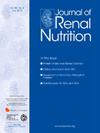腹膜透析非糖尿病患者腹膜葡萄糖吸收、血脂代谢与心血管疾病风险之间的关系。
IF 3.2
3区 医学
Q2 NUTRITION & DIETETICS
引用次数: 0
摘要
背景:摄入过多的糖会增加能量代谢负担和心血管疾病(CVD)风险。腹膜透析(PD)患者吸收的葡萄糖比世界卫生组织建议的要多得多,但与心血管疾病的关系尚不清楚:目的:确定腹膜葡萄糖吸收、脂代谢和心血管疾病之间的关系:我们采用广义加和混合效应和混合效应 Cox 比例危险模型来评估腹膜葡萄糖吸收对血脂状况和心血管疾病风险的影响。我们使用蛋白质摄入量(归一化蛋白质氮外观[nPNA]和归一化蛋白质分解率[nPCR]用于评估蛋白质摄入量)和高敏C反应蛋白(hs-CRP)进行了亚组分析:经多变量调整后,腹膜葡萄糖吸收量每增加10克/天,胆固醇就会增加0.145(95%置信区间[CI]:0.086-0.204)毫摩尔/升。没有观察到葡萄糖吸收与心血管疾病总风险之间的联系;但是,蛋白质摄入量和 hs-CRP 水平会影响葡萄糖吸收与心血管疾病风险之间的关系。nPNA 和 nPCR 值小于 1.0 g/(kg∙d)的患者患心血管疾病的风险较低(危险比 [HR] 95% CI 0.68 (0.46-0.98)),葡萄糖吸收量每增加 10 g/d。而hs-CRP水平≥3 mg/d或nPNA或nPCR值≥1.0 g/(kg∙d)的患者患心血管疾病的风险较高(HR 95% CI 1.32 (1.07-1.63); 1.31 (1.02-1.68)),葡萄糖吸收每增加10 g/d:我们的研究发现腹膜葡萄糖吸收与血脂谱之间存在正相关。在蛋白质摄入量较低的患者中,葡萄糖吸收量的增加与心血管疾病的风险降低有关,而在hs-CRP或蛋白质摄入量较高的腹膜透析患者中,心血管疾病的风险较高。本文章由计算机程序翻译,如有差异,请以英文原文为准。
Association Between Peritoneal Glucose Absorption, Lipid Metabolism, and Cardiovascular Disease Risk in Nondiabetic Patients on Peritoneal Dialysis
Background
Excessive sugar intake increases the energy metabolic burden and the risk of cardiovascular disease (CVD). Patients on peritoneal dialysis absorb much more glucose than the World Health Organization recommends, but the link to CVD is unclear.
Objective
To identify the association between peritoneal glucose absorption, lipid metabolism, and CVD.
Methods
We applied generalized additive mixed effects and mixed effects Cox proportional hazard models to evaluate the impact of peritoneal glucose absorption on lipid profiles and CVD risk. We performed subgroup analyses by using protein intake (normalized protein nitrogen appearance [nPNA] and normalized protein catabolic rate [nPCR] were used to assess protein intake) and high-sensitivity C-reactive protein (hs-CRP).
Results
After multivariable adjustment, peritoneal glucose absorption per 10 g/d increase was associated with an increase in cholesterol of 0.145 (95% confidence interval [CI]: 0.086–0.204) mmol/L. No link with the total risk of CVD was observed; however, protein intake and hs-CRP levels affected the relationship between glucose absorption and CVD risk. Patients with values for nPNA and nPCR <1.0 g/(kg·d) were associated with a lower risk of CVD (hazard ratio [HR] 95% CI: 0.68 (0.46–0.98)) with glucose absorption per 10 g/d increase. While patients with hs-CRP levels ≥3 mg/d or values for nPNA or nPCR ≥1.0 g/(kg·d) were associated with a higher risk of CVD (HR 95% CI: 1.32 (1.07–1.63); 1.31 (1.02–1.68)) for glucose absorption per 10 g/d increase.
Conclusions
Our study found a positive correlation between peritoneal glucose absorption and lipid profiles. Increased glucose absorption was associated with a lower risk of CVD in lower protein intake patients and a higher risk of CVD in higher hs-CRP or protein intake levels in patients on peritoneal dialysis.
求助全文
通过发布文献求助,成功后即可免费获取论文全文。
去求助
来源期刊

Journal of Renal Nutrition
医学-泌尿学与肾脏学
CiteScore
5.70
自引率
12.50%
发文量
146
审稿时长
6.7 weeks
期刊介绍:
The Journal of Renal Nutrition is devoted exclusively to renal nutrition science and renal dietetics. Its content is appropriate for nutritionists, physicians and researchers working in nephrology. Each issue contains a state-of-the-art review, original research, articles on the clinical management and education of patients, a current literature review, and nutritional analysis of food products that have clinical relevance.
 求助内容:
求助内容: 应助结果提醒方式:
应助结果提醒方式:


